R. Scot Johns's Blog, page 24
April 2, 2011
Smashwords Releases "Saga of Beowulf"
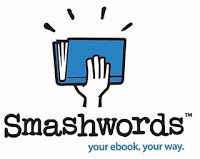 The 2-part editions of The Saga of Beowulf have been released through Smashwords with additional bonus content in each ebook.
Part I
now contains the deleted sequence "Edgtheow's Tale" cut from Chapter One, as well as the complete Glossaries for ease of reference, while
Part II
includes the Author's Afterword adaptation and research notes, plus the "Norse Rune Decoder" for deciphering the untranslated Rune passages given in each book. Additionally, all editions have had both front and rear cover art added to the internal file structure, as well as upgraded copyright and reference data.
The 2-part editions of The Saga of Beowulf have been released through Smashwords with additional bonus content in each ebook.
Part I
now contains the deleted sequence "Edgtheow's Tale" cut from Chapter One, as well as the complete Glossaries for ease of reference, while
Part II
includes the Author's Afterword adaptation and research notes, plus the "Norse Rune Decoder" for deciphering the untranslated Rune passages given in each book. Additionally, all editions have had both front and rear cover art added to the internal file structure, as well as upgraded copyright and reference data.At the same time both the Kindle and Nook editions have been updated to include the bonus material as well, so if you've purchased those be sure to re-download the new files. Both parts are available in multiple formats via Smashwords, including .prc, .ePub, .pdf, .lrf, and .rtf, with all files being DRM-free. Hence, you can read any version on any reader you want, without limitations, while the Kindle and Nook editions remain locked. I can only change this by deleting their current pages on Amazon and Barnes & Noble and creating all new pages, which is something I'm not currently prepared to do. However, all digital editions going forward will no longer be restricted with DRM encryption.
Distribution via iBooks, the Sony Reader store, Kobo store, and Diesel eBooks is currently pending shipment of the digital files, and should occur within a week or two.
That said, I've also decided to return the price of each book to the 70% royalty rate, which means a retail price of $2.99 for each part, and $4.99 for the complete edition. This is still much less than the equivalent print editions, which don't contain the bonus content. However, in case you missed the introductory .99¢ price, throughout this month you can still get them at that price via Smashwords using coupon code FE49C for Part I, and CM34L for Part II. These codes will expire May 2nd, so go get them now!
Published on April 02, 2011 15:24
March 29, 2011
The Saga of Beowulf, Two-Volume Edition
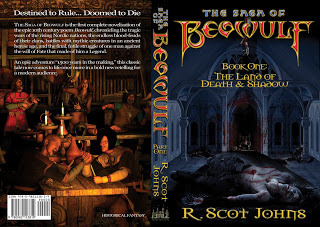 "The Saga of Beowulf" is now available in a two part edition, in both print and digital formats. Each part features new cover art created just for this release, as well as new subtitles for each book. Front cover art for book one was done by Dustin Neff (with some touch-ups added during layout), while the remaining art I did myself, as well as all titles, layout and typography.
"The Saga of Beowulf" is now available in a two part edition, in both print and digital formats. Each part features new cover art created just for this release, as well as new subtitles for each book. Front cover art for book one was done by Dustin Neff (with some touch-ups added during layout), while the remaining art I did myself, as well as all titles, layout and typography. Each book is priced at $8.95 for the print edition and just .99¢ for either Nook or Kindle ebooks, making it cheaper than ever to read (not counting recent freebies). The new links to the left will take you to the Kindle pages on Amazon.
"Part I: The Land of Death & Shadow" contains the first 350 pages, comprising Beowulf's adventures in Denmark, including the battle with the ogre Grendel and the expedition to the Troll-Hag's lair, and culminating in a dramatic finale based on a number of historical details almost always overlooked in retellings and general studies of Beowulf (for more on that visit the Author's Adaptation Notes section at fantasycastlebooks.com).
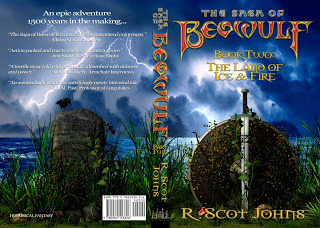 "Part II: The Land of Ice & Fire"
continues the saga as Beowulf returns to the homeland he had fled, only to be horrified by what he finds. The concluding section consists of the most historically verifiable events from the original tale, including the ill-fated raid on Francia, the tragic blood-feuds of the Swedes and Geats, and culminating in the epic fight against the dragon.
"Part II: The Land of Ice & Fire"
continues the saga as Beowulf returns to the homeland he had fled, only to be horrified by what he finds. The concluding section consists of the most historically verifiable events from the original tale, including the ill-fated raid on Francia, the tragic blood-feuds of the Swedes and Geats, and culminating in the epic fight against the dragon. Book two runs 310 pages long in print, with a detailed glossary of names included. And while both books contain the map and family trees, only the second part includes the glossary. However, these are all available online at the Fantasy Castle Books website. A new page filled with artwork for the outer jackets has been posted up there as well, so be sure to check that out, as you can view the image details in higher resolution than you can elsewhere.
So while 350 pages is still a substantial work, if you've been daunted by the thought of diving into the full 640 page monster you can now test the waters a bit more casually by reading just Part I, which contains the most well-known adventures from this classic tale of historical fantasy, and can be read alone without ever delving into Part II.
Of course, if you really want to know how it all turns out...

Published on March 29, 2011 16:08
March 12, 2011
E-Book Lending Clubs
Since December, when Amazon followed Barnes & Noble's lead in allowing ebook lending on its e-reader, several "lending clubs" have sprung up to circumvent the built-in lending limitations. Since each ebook can only be lent out once - ever - and for only 14 days, the number of titles available among any given circle of friends is inherently restricted. And unlike Nook ebooks, Kindle titles aren't available through any of the many public library e-lending programs out there.
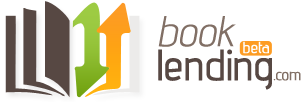 As a result, the first ebook lending group to appear was called the Kindle Lending Club, since renamed BookLending.com for legal reasons. Initially designed to overcome the Kindle platform's lack of a "Borrow" button (there is only a "Lend" option on Amazon, so you had to know someone who had the book and ask them for it specifically), it has rapidly morphed into an open library where users from all over the globe can borrow books (though only those within the USA can lend them out at present). BookLending now has 16,000 members who have loaned over 20,000 books since its inception just two months ago. LendInk.com quickly followed suit, and Lendle.me appeared in early February.
As a result, the first ebook lending group to appear was called the Kindle Lending Club, since renamed BookLending.com for legal reasons. Initially designed to overcome the Kindle platform's lack of a "Borrow" button (there is only a "Lend" option on Amazon, so you had to know someone who had the book and ask them for it specifically), it has rapidly morphed into an open library where users from all over the globe can borrow books (though only those within the USA can lend them out at present). BookLending now has 16,000 members who have loaned over 20,000 books since its inception just two months ago. LendInk.com quickly followed suit, and Lendle.me appeared in early February.
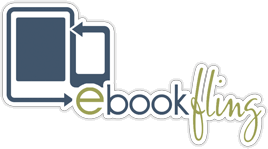 The newest ebook lending club to enter the fray is eBookFling, which launches Monday. While both Lendle.me and BookLending.com only allow the exchange of Kindle editions, eBookFling will follow LendInk's lead and also offer Nook ebooks, making the Nook the most lend-friendly ebook platform to date (since they use the open ePub format all e-lending libraries offer, and have a library loan program right on the device). Nook ebooks were, in fact, the first to be lendable from within a dedicated reading device, though the Kindle lending programs have so far been the most successful, due no doubt to the Kindle's larger market share.
The newest ebook lending club to enter the fray is eBookFling, which launches Monday. While both Lendle.me and BookLending.com only allow the exchange of Kindle editions, eBookFling will follow LendInk's lead and also offer Nook ebooks, making the Nook the most lend-friendly ebook platform to date (since they use the open ePub format all e-lending libraries offer, and have a library loan program right on the device). Nook ebooks were, in fact, the first to be lendable from within a dedicated reading device, though the Kindle lending programs have so far been the most successful, due no doubt to the Kindle's larger market share.
 All four sites are free to join, though each has its own requirements to lend and borrow. While both BookLending and LendInk allow you to borrow ebooks without loaning any out yourself, or even having any to loan, both Lendle and the new eBookFling require that its members loan as well as borrow books. Otherwise the inventory would quickly be depleted. So far the clubs are new enough that at present there's a constant influx of new members, and consequently new ebooks available for loan. But this will change as memberships begin to plateau off, and availability will be limited to newly acquired titles.
All four sites are free to join, though each has its own requirements to lend and borrow. While both BookLending and LendInk allow you to borrow ebooks without loaning any out yourself, or even having any to loan, both Lendle and the new eBookFling require that its members loan as well as borrow books. Otherwise the inventory would quickly be depleted. So far the clubs are new enough that at present there's a constant influx of new members, and consequently new ebooks available for loan. But this will change as memberships begin to plateau off, and availability will be limited to newly acquired titles.
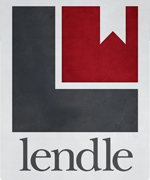 To address this issue, Lendle gives you two free loans at signup, but then requires you to loan a book before another can be borrowed, so that as long as you are lending you can continue to borrow. In a similar fashion, eBookFling will give credits for each ebook loaned, with each one borrowed costing one credit. The unique twist here, however, is that you can purchase credits for $1.99 if you have no titles available to loan, or no one has requested what you've got to offer (obviously not something you want to do for an ebook you can buy for that amount or less).
To address this issue, Lendle gives you two free loans at signup, but then requires you to loan a book before another can be borrowed, so that as long as you are lending you can continue to borrow. In a similar fashion, eBookFling will give credits for each ebook loaned, with each one borrowed costing one credit. The unique twist here, however, is that you can purchase credits for $1.99 if you have no titles available to loan, or no one has requested what you've got to offer (obviously not something you want to do for an ebook you can buy for that amount or less).
However, I have to say that I'm a little iffy on the legalities of charging a fee to borrow an ebook, which essentially amounts to renting a title, and as far as I know ebooks aren't licensed for that purpose (at least no one has asked me for the rights to do so with mine, and if they did I would expect a royalty from the proceeds). Video rental outlets, for example, require a licensing agreement with the film studios' distributors, and I see no reason why ebooks should be any different.
Each of these sites allows you to see and make requests for ebooks no members may actually have to loan (now or ever), but Lendle has a handy "Available Now" feature that only shows you books that are actually available for loan at the moment. Otherwise you simply have to make a request and hope somebody fills it, although it may be days or months, or even never for the rarer or less popular titles. And, of course, not all books are loan-enabled by their publishers, and some of these sites inform you of this while others don't. You'll just have to check them out and see which meets your needs.

 As a result, the first ebook lending group to appear was called the Kindle Lending Club, since renamed BookLending.com for legal reasons. Initially designed to overcome the Kindle platform's lack of a "Borrow" button (there is only a "Lend" option on Amazon, so you had to know someone who had the book and ask them for it specifically), it has rapidly morphed into an open library where users from all over the globe can borrow books (though only those within the USA can lend them out at present). BookLending now has 16,000 members who have loaned over 20,000 books since its inception just two months ago. LendInk.com quickly followed suit, and Lendle.me appeared in early February.
As a result, the first ebook lending group to appear was called the Kindle Lending Club, since renamed BookLending.com for legal reasons. Initially designed to overcome the Kindle platform's lack of a "Borrow" button (there is only a "Lend" option on Amazon, so you had to know someone who had the book and ask them for it specifically), it has rapidly morphed into an open library where users from all over the globe can borrow books (though only those within the USA can lend them out at present). BookLending now has 16,000 members who have loaned over 20,000 books since its inception just two months ago. LendInk.com quickly followed suit, and Lendle.me appeared in early February. The newest ebook lending club to enter the fray is eBookFling, which launches Monday. While both Lendle.me and BookLending.com only allow the exchange of Kindle editions, eBookFling will follow LendInk's lead and also offer Nook ebooks, making the Nook the most lend-friendly ebook platform to date (since they use the open ePub format all e-lending libraries offer, and have a library loan program right on the device). Nook ebooks were, in fact, the first to be lendable from within a dedicated reading device, though the Kindle lending programs have so far been the most successful, due no doubt to the Kindle's larger market share.
The newest ebook lending club to enter the fray is eBookFling, which launches Monday. While both Lendle.me and BookLending.com only allow the exchange of Kindle editions, eBookFling will follow LendInk's lead and also offer Nook ebooks, making the Nook the most lend-friendly ebook platform to date (since they use the open ePub format all e-lending libraries offer, and have a library loan program right on the device). Nook ebooks were, in fact, the first to be lendable from within a dedicated reading device, though the Kindle lending programs have so far been the most successful, due no doubt to the Kindle's larger market share. All four sites are free to join, though each has its own requirements to lend and borrow. While both BookLending and LendInk allow you to borrow ebooks without loaning any out yourself, or even having any to loan, both Lendle and the new eBookFling require that its members loan as well as borrow books. Otherwise the inventory would quickly be depleted. So far the clubs are new enough that at present there's a constant influx of new members, and consequently new ebooks available for loan. But this will change as memberships begin to plateau off, and availability will be limited to newly acquired titles.
All four sites are free to join, though each has its own requirements to lend and borrow. While both BookLending and LendInk allow you to borrow ebooks without loaning any out yourself, or even having any to loan, both Lendle and the new eBookFling require that its members loan as well as borrow books. Otherwise the inventory would quickly be depleted. So far the clubs are new enough that at present there's a constant influx of new members, and consequently new ebooks available for loan. But this will change as memberships begin to plateau off, and availability will be limited to newly acquired titles. To address this issue, Lendle gives you two free loans at signup, but then requires you to loan a book before another can be borrowed, so that as long as you are lending you can continue to borrow. In a similar fashion, eBookFling will give credits for each ebook loaned, with each one borrowed costing one credit. The unique twist here, however, is that you can purchase credits for $1.99 if you have no titles available to loan, or no one has requested what you've got to offer (obviously not something you want to do for an ebook you can buy for that amount or less).
To address this issue, Lendle gives you two free loans at signup, but then requires you to loan a book before another can be borrowed, so that as long as you are lending you can continue to borrow. In a similar fashion, eBookFling will give credits for each ebook loaned, with each one borrowed costing one credit. The unique twist here, however, is that you can purchase credits for $1.99 if you have no titles available to loan, or no one has requested what you've got to offer (obviously not something you want to do for an ebook you can buy for that amount or less). However, I have to say that I'm a little iffy on the legalities of charging a fee to borrow an ebook, which essentially amounts to renting a title, and as far as I know ebooks aren't licensed for that purpose (at least no one has asked me for the rights to do so with mine, and if they did I would expect a royalty from the proceeds). Video rental outlets, for example, require a licensing agreement with the film studios' distributors, and I see no reason why ebooks should be any different.
Each of these sites allows you to see and make requests for ebooks no members may actually have to loan (now or ever), but Lendle has a handy "Available Now" feature that only shows you books that are actually available for loan at the moment. Otherwise you simply have to make a request and hope somebody fills it, although it may be days or months, or even never for the rarer or less popular titles. And, of course, not all books are loan-enabled by their publishers, and some of these sites inform you of this while others don't. You'll just have to check them out and see which meets your needs.

Published on March 12, 2011 12:21
March 11, 2011
2010 by the Numbers...
The International Data Corp (IDC) yesterday released a report detailing the final figures for 2010 tablet and e-reader device sales, detailing the booming digital trend. Overall sales blew out all predicted estimates by quite a bit (even IDC's own from January), including a whopping leap for dedicated e-readers from the Yankee Group's earlier estimate of 5.99 million units by year end to an actual figure of 12.8 million, a 338% increase from the prior year's total of 2.92 million. More than 6 million units shipped in the final quarter of 2010 alone, twice as many in three months as all of 2009 combined.
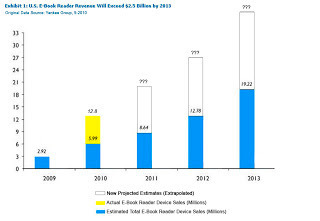
Revised e-Reader Sales Estimates
Consequently, I've updated the original Yankee Group projections chart for e-Reader sales to include the actual figures for the year, with revised estimates extrapolated across the next three years (assuming a relatively stable and sustained increase of around 200% growth, rather than the more voracious 300+%). In all likelihood, dedicated e-Reader sales will taper off a bit this year, with most of the attention focused on tablet competition.
Breaking down the numbers, Amazon held on to first place, with their lead however shrinking to just 48% of market share, up from January's 41.5% but down a ways from last February when they held somewhere around a 65% share. Doing the math, that means Amazon sold some 5.76 million Kindles throughout 2010. In the meantime, the NookColor was born and Pandigital's Novel line apparently took off: the former just barely eked out the second spot, with Pandigital coming in a narrow third. Hanvon claimed the fourth spot with its line of eInk readers, including the first release of a color e-Ink screen. Meanwhile, Sony Reader came in a distant fifth with a total of 800,000 units sold for 6.25% of sales (and that was up 80.7% during the final quarter of the year). Exact percentages weren't provided in the press release, but based on those that were, as well as January's figures, the split should look something like 48/18/16/8/6, give or take, with a little left for the bottom feeders. Interestingly, fourth place Hanvon wasn't in the January picture at all.
And that's just the story for dedicated e-readers, which does not include multi-function tablets.
In that category the final tally topped out at an astounding 18.1 million units. Apple held on to an 83% share, down ten percent overall from its earlier high of 93% due to a weaker 73% showing in the fourth quarter, a drop brought on almost entirely by the release of Samsung's Galaxy Tab, which came away with 17% of holiday season sales. And while tablet sales are expected to soar this year, the competition will increase as well. However, with media tablets on track to reach 50 million by the end of 2011, each percentage point will account for roughly three times the volume of 2010. In other words, Apple would have to lose a lot of ground not to top the iPad's first impressive year.
One of the more interesting aspects of all this is the ratio of tablet sales to that of dedicated e-Readers. With the latter achieving only 70% of the volume of the former, and color touchscreen readers gaining ground, expect to see a completely revamped Kindle out this August.


Revised e-Reader Sales Estimates
Consequently, I've updated the original Yankee Group projections chart for e-Reader sales to include the actual figures for the year, with revised estimates extrapolated across the next three years (assuming a relatively stable and sustained increase of around 200% growth, rather than the more voracious 300+%). In all likelihood, dedicated e-Reader sales will taper off a bit this year, with most of the attention focused on tablet competition.
Breaking down the numbers, Amazon held on to first place, with their lead however shrinking to just 48% of market share, up from January's 41.5% but down a ways from last February when they held somewhere around a 65% share. Doing the math, that means Amazon sold some 5.76 million Kindles throughout 2010. In the meantime, the NookColor was born and Pandigital's Novel line apparently took off: the former just barely eked out the second spot, with Pandigital coming in a narrow third. Hanvon claimed the fourth spot with its line of eInk readers, including the first release of a color e-Ink screen. Meanwhile, Sony Reader came in a distant fifth with a total of 800,000 units sold for 6.25% of sales (and that was up 80.7% during the final quarter of the year). Exact percentages weren't provided in the press release, but based on those that were, as well as January's figures, the split should look something like 48/18/16/8/6, give or take, with a little left for the bottom feeders. Interestingly, fourth place Hanvon wasn't in the January picture at all.
And that's just the story for dedicated e-readers, which does not include multi-function tablets.
In that category the final tally topped out at an astounding 18.1 million units. Apple held on to an 83% share, down ten percent overall from its earlier high of 93% due to a weaker 73% showing in the fourth quarter, a drop brought on almost entirely by the release of Samsung's Galaxy Tab, which came away with 17% of holiday season sales. And while tablet sales are expected to soar this year, the competition will increase as well. However, with media tablets on track to reach 50 million by the end of 2011, each percentage point will account for roughly three times the volume of 2010. In other words, Apple would have to lose a lot of ground not to top the iPad's first impressive year.
One of the more interesting aspects of all this is the ratio of tablet sales to that of dedicated e-Readers. With the latter achieving only 70% of the volume of the former, and color touchscreen readers gaining ground, expect to see a completely revamped Kindle out this August.

Published on March 11, 2011 20:35
March 7, 2011
Free eBook Giveaway!
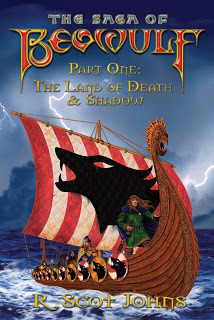 In recognition of "Read An eBook Week," through this coming Saturday I will be giving away an unlimited number of copies of "The Saga of Beowulf, Part I: The Land of Death & Shadow" in unprotected ePub, Kindle, and PDF formats. This is the complete 343-page first book in the 2010 two part Revised Edition.
In recognition of "Read An eBook Week," through this coming Saturday I will be giving away an unlimited number of copies of "The Saga of Beowulf, Part I: The Land of Death & Shadow" in unprotected ePub, Kindle, and PDF formats. This is the complete 343-page first book in the 2010 two part Revised Edition.To download your FREE eBook in the format of your choice, either "friend" me and send a message via Facebook, or sign up for my mailing list at Fantasy Castle Books. Be sure to mention your preferred format and provide a name and email address to which I can reply with a download link (I will only use your contact info to send you periodic updates on my upcoming book projects, occasionally with links to bonus materials available to list members only!).
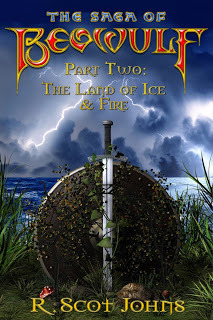 In addition, share this giveaway with a friend and complete the series by receiving a link to download the 340-page ebook of "Part II: The Land of Ice & Fire" for FREE as well! Just have your friend mention your name when they contact me for their free ebook of Part I, and I'll forward the second link to you right away. But be sure to hurry, as this is a limited time offer!
In addition, share this giveaway with a friend and complete the series by receiving a link to download the 340-page ebook of "Part II: The Land of Ice & Fire" for FREE as well! Just have your friend mention your name when they contact me for their free ebook of Part I, and I'll forward the second link to you right away. But be sure to hurry, as this is a limited time offer!All files are unprotected and free for personal use, so once you've downloaded the format of your choice, feel free to make as many copies as you like and give them out to all your friends and family (cheapest birthday present ever!). And for more about the books, including "behind the scenes" production drafts and artwork, author's notes and study guides, visit the Saga of Beowulf pages at fantasycastlebooks.com.

Published on March 07, 2011 00:00
March 6, 2011
Read an eBook Week
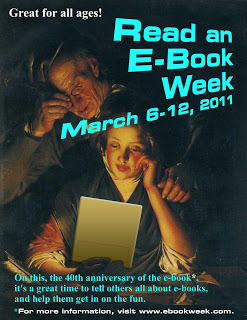
Click for Hi-Rez Promo Sheet to Print and Post!
Today officially begins this year's installment of "Read an e-Book Week," first recognized in 2004 as an effort to promote the benefits of electronic texts, from increasing literacy via widespread ebook distribution to the practical convenience of e-bookshelf portability. Authors, publishers and retailers around the world are joining together to offer discounts and specials throughout the week, including a number of giveaways and contests with prizes donated by the likes of eInk and Kobo.
With this year marking the 40th anniversary of the e-book, the week-long celebration offers a wide variety of events worldwide, including digital book readings by authors in schools and libraries, as well as promotional booths and kiosks in malls and bookstores everywhere. Visit the eBook Week website to find out where and when, and be sure to enter the contests to win one of three Kobo eReaders, two eInk watches or a Barnes & Noble Nook. And of course, be sure to check out all the info on the site, from the history of electronic texts and readers to an explanation of how e-ink works.
But most important, be sure to read an eBook this week!

Published on March 06, 2011 11:43
February 28, 2011
Borders Lowers Self-Pub Fees
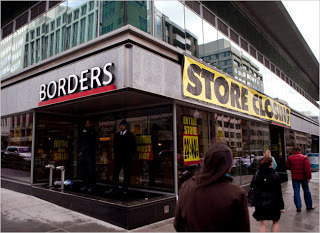 In an apparent effort to keep one segment of its digital division alive while the brick-and-mortar world crumbles all around them, Borders today dramatically lowered the setup fees for its fledgling "Get Published" program - for the second time since its October debut (see my original analysis of the program here). The first was the February Valentine's Day promotion, which ran at such a discount that it really would have pissed me off had I been one of the four people who paid the full price in the first four months of the program's life (and you'll see in a minute that I'm not making that number up).
In an apparent effort to keep one segment of its digital division alive while the brick-and-mortar world crumbles all around them, Borders today dramatically lowered the setup fees for its fledgling "Get Published" program - for the second time since its October debut (see my original analysis of the program here). The first was the February Valentine's Day promotion, which ran at such a discount that it really would have pissed me off had I been one of the four people who paid the full price in the first four months of the program's life (and you'll see in a minute that I'm not making that number up).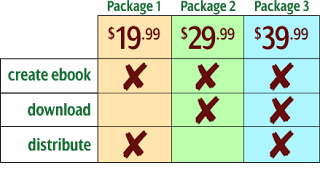 Initially rolled out at a hefty price tag of $199.99, the "advance" package can now by had for a mere $39 bucks, while the basic $89 version is just $19.99. On top of this, Borders has "drastically restructured" their author royalty payments, offering a 95-100% "post-retail" fee schedule - that is, after Amazon or iBooks have taken 30%, B&N take 35%, or Kobo gleans their 45% share off the top. In other words, Borders is giving up their additional 25% cut. Isn't that just generous of them?
Initially rolled out at a hefty price tag of $199.99, the "advance" package can now by had for a mere $39 bucks, while the basic $89 version is just $19.99. On top of this, Borders has "drastically restructured" their author royalty payments, offering a 95-100% "post-retail" fee schedule - that is, after Amazon or iBooks have taken 30%, B&N take 35%, or Kobo gleans their 45% share off the top. In other words, Borders is giving up their additional 25% cut. Isn't that just generous of them?What this tells me is that no one has bothered to pay the higher price, and now they'll take whatever they can get to keep from shutting down another floundering division - after all, why lose income on something if it's selling, especially when you clearly need the funds? It doesn't take a brilliant analyst to smell the desperation.
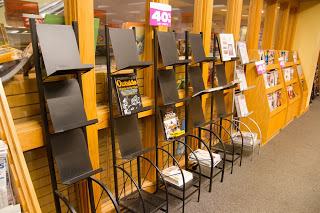 So, curious to see how the program was faring, I followed the "see more titles" link at the bottom of the Get Published page (under the last section where it says "Who Have We Published?"). This results in a list of 64 titles in total, of which the publication dates show three to have been released in October and just one in November (I told you I didn't make that number up), with the remaining 60 released between February 5th and 19th - obviously resulting from the Valentine's Day "promotion" (read: desperation). You can also get this list by searching under ebooks for "Feedbrewer" as the publisher (why it's not BookBrewer as in the promo materials I can't tell you). None of those first four titles have reviews, and since Borders doesn't provide sales rank data like Amazon or B&N.com there's no way to tell if any copies have actually sold. But I'm guessing that since Borders no longer gets a cut of the royalty they probably don't really care.
So, curious to see how the program was faring, I followed the "see more titles" link at the bottom of the Get Published page (under the last section where it says "Who Have We Published?"). This results in a list of 64 titles in total, of which the publication dates show three to have been released in October and just one in November (I told you I didn't make that number up), with the remaining 60 released between February 5th and 19th - obviously resulting from the Valentine's Day "promotion" (read: desperation). You can also get this list by searching under ebooks for "Feedbrewer" as the publisher (why it's not BookBrewer as in the promo materials I can't tell you). None of those first four titles have reviews, and since Borders doesn't provide sales rank data like Amazon or B&N.com there's no way to tell if any copies have actually sold. But I'm guessing that since Borders no longer gets a cut of the royalty they probably don't really care. The great irony in all this is that you can set your ebook up yourself for free on Amazon, Barnes & Noble, or Kobo - and Smashwords will get you on iBooks (albeit for a cut of the royalty). The press release states that Borders will only offer these lower prices "as long as we continue to see high demand" - meaning not that the prices will go back up otherwise, but that the program will very likely cease to exist ...which is where I'll place my bet.
The great irony in all this is that you can set your ebook up yourself for free on Amazon, Barnes & Noble, or Kobo - and Smashwords will get you on iBooks (albeit for a cut of the royalty). The press release states that Borders will only offer these lower prices "as long as we continue to see high demand" - meaning not that the prices will go back up otherwise, but that the program will very likely cease to exist ...which is where I'll place my bet.
Published on February 28, 2011 12:48
February 27, 2011
Tablet Wars
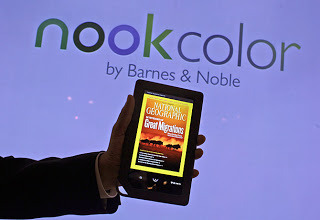 Poised on the eve of the iPad 2's media presentation this Wednesday, Barnes & Noble this weekend hosted an in-store Nook event to promote their own foray into the touchscreen tablet market. While the NookColor is ostensibly a "dedicated" e-Reader, its Android OS and expected first quarter launch of an app market devoted to Nook specific content push it squarely into the emerging tablet competition. Additionally, an array of recent hacks have made it a much more capable device than what it was initially intended to be (TechRepublic, for example, provides step by step instructions on how to upgrade your NookColor to the tablet-specific Android 3.0 Honeycomb OS). But even as an e-reading device, the color Nook has a lot to offer, particularly when it comes to magazines and children's illustrated books, which look astounding on its 7" LCD screen. Needless to say, I was impressed enough to give it serious consideration, particularly given my concern with displaying the full-color illustrations I've been working on of late for my upcoming graphic novel series. As with most devices, however, the NookColor does have its down sides, among them my desire for a full-sized 10" screen for viewing two-page book layouts, and its shorter battery life when compared to the Kindle. But at $250 it's certainly a major player. And as a reading experience for anything but basic text it puts the Kindle to shame.
Poised on the eve of the iPad 2's media presentation this Wednesday, Barnes & Noble this weekend hosted an in-store Nook event to promote their own foray into the touchscreen tablet market. While the NookColor is ostensibly a "dedicated" e-Reader, its Android OS and expected first quarter launch of an app market devoted to Nook specific content push it squarely into the emerging tablet competition. Additionally, an array of recent hacks have made it a much more capable device than what it was initially intended to be (TechRepublic, for example, provides step by step instructions on how to upgrade your NookColor to the tablet-specific Android 3.0 Honeycomb OS). But even as an e-reading device, the color Nook has a lot to offer, particularly when it comes to magazines and children's illustrated books, which look astounding on its 7" LCD screen. Needless to say, I was impressed enough to give it serious consideration, particularly given my concern with displaying the full-color illustrations I've been working on of late for my upcoming graphic novel series. As with most devices, however, the NookColor does have its down sides, among them my desire for a full-sized 10" screen for viewing two-page book layouts, and its shorter battery life when compared to the Kindle. But at $250 it's certainly a major player. And as a reading experience for anything but basic text it puts the Kindle to shame.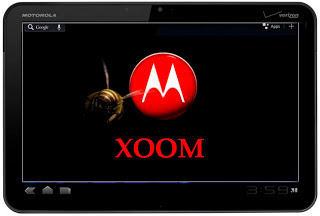 However, both the iPad and the NookColor have some serious competition. In preparation for my own impending decision on whether to get an iPad 2 or not (a decision made more tentative by Apple's recent pricing hi-jinx in its app store), I've been looking closely at the new Motorola Xoom, which launched on Thursday as the first tablet to officially run on Honeycomb. I got my hands on one yesterday at my local Best Buy, and I have to tell you, the Xoom's features are truly stunning, especially for a first generation model. And while it has its pros and cons (just as the iPad does), it is the first real contender in the brewing tablet wars, particularly given its spacious 10.1" screen and dual-core processor. Fast! I saw not a jitter or delay in twenty minutes of pressing and prodding its ultra-responsive screen. HD video was crystal clear and super smooth. And with an Android OS every ebook reading app you could ever want or need (except iBooks, of course) is readily available. A major detracting factor, however, is the seemingly last-minute decision to disable the included SD card slot (as well as its $800 price tag - $600 with a 2-year Verizon data plan at $20 a month). But both the SD capability and a Flash-friendly upgrade are promised within the year, so it's an entry worthy of consideration.
However, both the iPad and the NookColor have some serious competition. In preparation for my own impending decision on whether to get an iPad 2 or not (a decision made more tentative by Apple's recent pricing hi-jinx in its app store), I've been looking closely at the new Motorola Xoom, which launched on Thursday as the first tablet to officially run on Honeycomb. I got my hands on one yesterday at my local Best Buy, and I have to tell you, the Xoom's features are truly stunning, especially for a first generation model. And while it has its pros and cons (just as the iPad does), it is the first real contender in the brewing tablet wars, particularly given its spacious 10.1" screen and dual-core processor. Fast! I saw not a jitter or delay in twenty minutes of pressing and prodding its ultra-responsive screen. HD video was crystal clear and super smooth. And with an Android OS every ebook reading app you could ever want or need (except iBooks, of course) is readily available. A major detracting factor, however, is the seemingly last-minute decision to disable the included SD card slot (as well as its $800 price tag - $600 with a 2-year Verizon data plan at $20 a month). But both the SD capability and a Flash-friendly upgrade are promised within the year, so it's an entry worthy of consideration.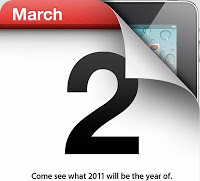 As for the iPad 2, we'll just have to wait and see what Steve Jobs and Co. have in store for us on Wednesday. Given what I've seen speculating around the Web, I can't say I'm overly excited. Just a few months ago I was chomping at the bit to get my hands on a second generation unit. But the rumors haven't been particularly impressive, and most of the confirmed upgrades have little real advantage for me. Cameras? Who cares? Aside from businessmen on conference calls, really who needs another camera? Wall Street Journal confirms a dual cam setup for the iPad 2, with a 0.3 mp face cam and whopping 1mp rear shooter. But doesn't pretty much every decent phone come with megapixel cams as standard fare these days? My Droid is equipped with an 8-megapixel snapper, so I can hardly imagine hefting up an iPad to capture Mount Rushmore on a summer outing. And while the iPad 2 will sport the new smoking fast dual-core A5 processor, screen resolution is rumored to be unchanged (or only marginally at any rate), aside from a better anti-glare coating (in answer to Amazon's screen-glare mocking adverts). There will be no SD slot, no micro-USB, and no real improvement in onboard sonic capability, if the case mockups are at all accurate. But then, Jobs & Co are notoriously sneaky and secretive in their pre-release data hoarding (eg., the iPhone 4's retina display), so we may be seeing a huge leap in resolution to something like a 2048x1536 or so. Unlikely, but possible. So basically we're left with a flat-backed, thinner and slightly lighter 2011 model with moderate performance upgrades inside to better handle the multitasking capability that should have been there all along.
As for the iPad 2, we'll just have to wait and see what Steve Jobs and Co. have in store for us on Wednesday. Given what I've seen speculating around the Web, I can't say I'm overly excited. Just a few months ago I was chomping at the bit to get my hands on a second generation unit. But the rumors haven't been particularly impressive, and most of the confirmed upgrades have little real advantage for me. Cameras? Who cares? Aside from businessmen on conference calls, really who needs another camera? Wall Street Journal confirms a dual cam setup for the iPad 2, with a 0.3 mp face cam and whopping 1mp rear shooter. But doesn't pretty much every decent phone come with megapixel cams as standard fare these days? My Droid is equipped with an 8-megapixel snapper, so I can hardly imagine hefting up an iPad to capture Mount Rushmore on a summer outing. And while the iPad 2 will sport the new smoking fast dual-core A5 processor, screen resolution is rumored to be unchanged (or only marginally at any rate), aside from a better anti-glare coating (in answer to Amazon's screen-glare mocking adverts). There will be no SD slot, no micro-USB, and no real improvement in onboard sonic capability, if the case mockups are at all accurate. But then, Jobs & Co are notoriously sneaky and secretive in their pre-release data hoarding (eg., the iPhone 4's retina display), so we may be seeing a huge leap in resolution to something like a 2048x1536 or so. Unlikely, but possible. So basically we're left with a flat-backed, thinner and slightly lighter 2011 model with moderate performance upgrades inside to better handle the multitasking capability that should have been there all along.Still, all things considered, it's still arguably the best tablet on the market, and looks likely to remain so for the foreseeable future, since all other major players are months away from launch yet, or still just rumors (i.e. the Galaxy Tab 10.1). Motorola was smart to get its product out the door well before Apple grabs up another chunk of market share.

Published on February 27, 2011 12:24
February 25, 2011
e-Lending Libraries
 OpenLibrary this week launched a new ebook lending program featuring a collection of 80,000 titles, readable via IA's in-browser e-reader, or downloadable as PDF or ePub files. Patrons may check out up to five titles at a time for a period of two weeks. The new project is an offshoot of The Internet Archive, one the best online digital classics repositories, working in collaboration with 150 libraries to bring the world's classic literature to readers in the modern age. Consequently, the collection consists in great part of modern editions of public domain works, many of which are available in free (though often poorly edited) editions elsewhere.
OpenLibrary this week launched a new ebook lending program featuring a collection of 80,000 titles, readable via IA's in-browser e-reader, or downloadable as PDF or ePub files. Patrons may check out up to five titles at a time for a period of two weeks. The new project is an offshoot of The Internet Archive, one the best online digital classics repositories, working in collaboration with 150 libraries to bring the world's classic literature to readers in the modern age. Consequently, the collection consists in great part of modern editions of public domain works, many of which are available in free (though often poorly edited) editions elsewhere. The new homepage interface now features a row of lending recommendations as well as a "Return Cart" for recently-returned titles, along with a third row of non-lendable entries (though there are generally plenty of links to free download pages therein). Like Wikipedia, OpenLibrary is "an open, editable library catalog," where users can add or correct catalog entries. The project's rather ambitious goal is to build an ebook archive with "a web page for every book ever published."
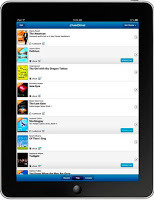 Meanwhile, OverDrive recently released its new Media Console app for iOS and Android tablets, which functions as an interface for users to borrow ebooks from local libraries with an e-lending program. Serving more than 13,000 libraries, OverDrive hosts a catalog of 400,000 titles, including many new releases. I've been using OverDrive to download both ebooks and audio titles from my local library for several years now, using the web interface and a USB to transfer the content to my iPod or (now hopelessly antiquated) iPaq ereader. However, the new Media Console app makes it possible to borrow titles from right within the device.
Meanwhile, OverDrive recently released its new Media Console app for iOS and Android tablets, which functions as an interface for users to borrow ebooks from local libraries with an e-lending program. Serving more than 13,000 libraries, OverDrive hosts a catalog of 400,000 titles, including many new releases. I've been using OverDrive to download both ebooks and audio titles from my local library for several years now, using the web interface and a USB to transfer the content to my iPod or (now hopelessly antiquated) iPaq ereader. However, the new Media Console app makes it possible to borrow titles from right within the device.Unfortunately, the Kindle does not allow elending from libraries, and as I have yet to acquire a tablet I can't give you a personal review of the app. But in the following video Katie Boehret of The Wall Street Journal provides an in-depth analysis of the OverDrive interface and functionality (or read her post here).
While in-device ebook lending is still in its infancy, there are a growing number of digital libraries worldwide that offer ebook borrowing programs. Many are free, but some require membership fees or subscriptions. In addition, some public libraries offer non-resident cards. However, the OverDrive app should soon render this unnecessary. For a listing of digital lending libraries, visit this MobilRead wiki page, or contact your local library for details.

Published on February 25, 2011 14:55
February 22, 2011
CNET Survey
CNET has a survey up asking readers how much they would willingly pay for an ebook. The poll is still ongoing, so follow the link to add your own voice to the crowd. As of today, here are the results:
I've been harping on the end of the traditional publishing model for years, and the more I learn the less interested I am in having anything to do with it. For a stunningly insightful analysis of just how much publishers siphon off the top, read Joe Konrath's latest post here.

What's the most you'd spend for an e-book?For the record, I chose the $7.99 or less category (as did the majority of respondents), and had I the choice I would have selected $4.99 or less. My thoughts on this have shifted over the years, but the more I learn about the numbers being tossed around behind the scenes the less I empathize with publishers and brick-and-mortar stores like Borders, whose print edition costs are understandably high, but still want to charge as much for digital, even though there are no printing costs, no returns, no storage and no shipping fees (aside from a bit of broadband and some server space).
41.1% - $7.99 or less
33.7% - $9.99
14.0% - I don't read e-books
8.5% - $11.99
2.7% - $14.99 or more
Total votes: 5056
I've been harping on the end of the traditional publishing model for years, and the more I learn the less interested I am in having anything to do with it. For a stunningly insightful analysis of just how much publishers siphon off the top, read Joe Konrath's latest post here.

Published on February 22, 2011 06:09



